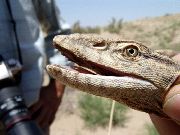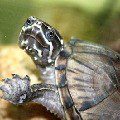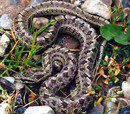
Monitor lizard gray
The gray monitor lizard (Varanus griseus) is a representative of the lizard suborder of the reptile class. The size of an adult animal, together with the tail, can reach a length of 150 cm, and weight up to 3.5 kg. The body of this animal is massive, equipped with strong legs with curved claws on the fingers. Like most monitor lizards, the gray monitor lizard has a very strong and long rounded tail. The color of the scales merges with the surrounding background, which is a good means for hiding from enemies and for catching prey, because not every animal is able to recognize the body of an animal that is grayish-brown with a reddish tint, which is hidden on the steppe plain. The lizard has dark spots and dots scattered all over its body, and almost parallel stripes run across the back and tail of the same color. On the head of the reptile are curved nostrils that open near the eyes. Such an anatomical structure will make it easier for the animal to explore holes, since the nostrils are not clogged with sand. The gray monitor lizard has strong and long teeth, in the oral cavity there are sharp, slightly recurved teeth that help to hold the victim. Throughout the life of the animal, they are erased and replaced with new ones.
Distribution
The gray monitor lives only in the driest areas of North Africa, Southwest Asia, Iran and Afghanistan. These lizards are common in South Kazakhstan and the republics of Central Asia, their distribution area stretches from the eastern coast of the Caspian Sea to the Tien Shan, in the north it reaches Ustyurt and the Aral Sea. Along the valley of the Syrdarya river, reptiles penetrated to the Fergana valley, and along the valley of the Amudarya river – to southwestern Tajikistan.
Life in nature
 In nature, gray monitor lizards inhabit various types of deserts and semi-deserts, such as sandy, clayey, loess and rocky. These animals are found on coastal cliffs, in tugai, periodically entering the lands cultivated by man.
In nature, gray monitor lizards inhabit various types of deserts and semi-deserts, such as sandy, clayey, loess and rocky. These animals are found on coastal cliffs, in tugai, periodically entering the lands cultivated by man.
Reptiles are active during the day and live in specially built burrows in which a certain microclimate is created. Monitor lizards themselves dig a hole or expand an existing one, which belonged to some rodent, having previously eaten the host. The depth of the dwelling can reach up to 4 meters in depth. In it, the reptile rests, hides from enemies and spends the winter months in hibernation, having previously plugged the entrance with an earthen plug.
These lizards come out of their hiding places daily, after the heat subsides, both to make a detour of their territory and to hunt, sometimes leaving it for a kilometer. The animal moves slowly, but, escaping from persecution, it can develop great speed, though only for short distances.
If the monitor lizard cannot solder, run away or was taken by surprise, then it immediately takes a stance – it opens its mouth wide, sticks out its tongue, hisses loudly and whips its tail in different directions, its body swells and becomes wide and flat.
Arabs are afraid of this animal because it is both bolder and meaner than all other lizards that are common in their country. If you scare this reptile in an open area, then it prepares for defense in seconds, jumps 1 meter in height with its tail and throws itself in the face or chest of a person, and on the belly of large animals, while inflicting severe lacerations on camels, horses and donkeys.
Gray monitor lizards eat almost anything they can find, including small mammals, birds and reptiles. The diet of young animals includes insects. Adult animals eat gerbils, mice, ground squirrels, hedgehogs, all kinds of lizards, small turtles, frogs and the like. Monitor lizards simply lick small prey with their tongue, and eggs, chicks and slow animals are strongly squeezed by their powerful jaws and quickly swallowed. The reptile pursues large prey, then, having caught it, quickly shakes it, presses it to the ground, strangles and swallows it. In scientific sources, there is information that the gray monitor lizard can even cope with a rattlesnake and a cobra.
When bitten by the described reptile, saliva enters the wound of the victim, which carries a huge amount of bacteria and microorganisms, which has strong toxic properties. When a person is bitten, his temperature rises, headache, nausea appear, and in advanced situations, severe suppuration of the wound and up to sepsis. Small animals, such as sparrows or rats, when administered as an intramuscular injection of monitor lizard saliva, stop moving after a while and die.
Animals receive the necessary amount of moisture, as a rule, with food, but if the reptile has such an opportunity, then it drinks water with pleasure, bathes and catches fish or crabs. While drinking, the monitor lizard dips its head up to the eyes into the pond, draws liquid into its mouth, and, raising it up, swallows.
Adult gray monitor lizards have practically no natural enemies. But young lizards often become victims of large birds of prey and honey badgers, they can also be eaten by a larger individual of their species.
Content in the apartment
Gray monitor lizards are not kept in apartment conditions due to the fact that they are very aggressive and require proper care and knowledge. They are in zoos and exotariums of the countries.
Reproduction
The mating behavior of gray monitor lizards is accompanied by demonstrations and ritual postures. Males enter the battle for the right of the strongest and, as a result, the possession of a female. Many animals after such fights remain scars for life.
Females of this species of monitor lizards begin to breed when they reach 3 years of age. In late June – early July, they dig deep winding burrows, in the wet sand of which they lay up to 23 eggs. Young lizards hatch from them in August-September and almost immediately after that they lie down for the winter. The cubs that are born are brightly colored, but with age their color fades. In the spring, after hibernation, they emerge from their burrows, having grown to 12 cm. Their growth will stop only when they reach 4 years of age.
Facts
 The skin of the gray monitor lizard has a very beautiful appearance and is durable, and as a result, at the beginning of the 20th century, leather products were made from it, such as bags, wallets, shoes. At that time, up to 20 thousand reptiles were killed in Central Asia, which led to a sharp decrease in the number of these animals in Turkmenistan and the South Kyzylkum. And only after a long period of time does it begin to recover.
The skin of the gray monitor lizard has a very beautiful appearance and is durable, and as a result, at the beginning of the 20th century, leather products were made from it, such as bags, wallets, shoes. At that time, up to 20 thousand reptiles were killed in Central Asia, which led to a sharp decrease in the number of these animals in Turkmenistan and the South Kyzylkum. And only after a long period of time does it begin to recover.
Muslims have very great prejudices towards these lizards. Its Turkic name is “kesel”, which means “illness” in translation. These peoples have a belief that a meeting with a monitor lizard brings misfortune and therefore every Muslim, when he met this animal, sought to kill him right on the spot.
At the moment, this species of animals is under protection and hunting for it is strictly prohibited.





